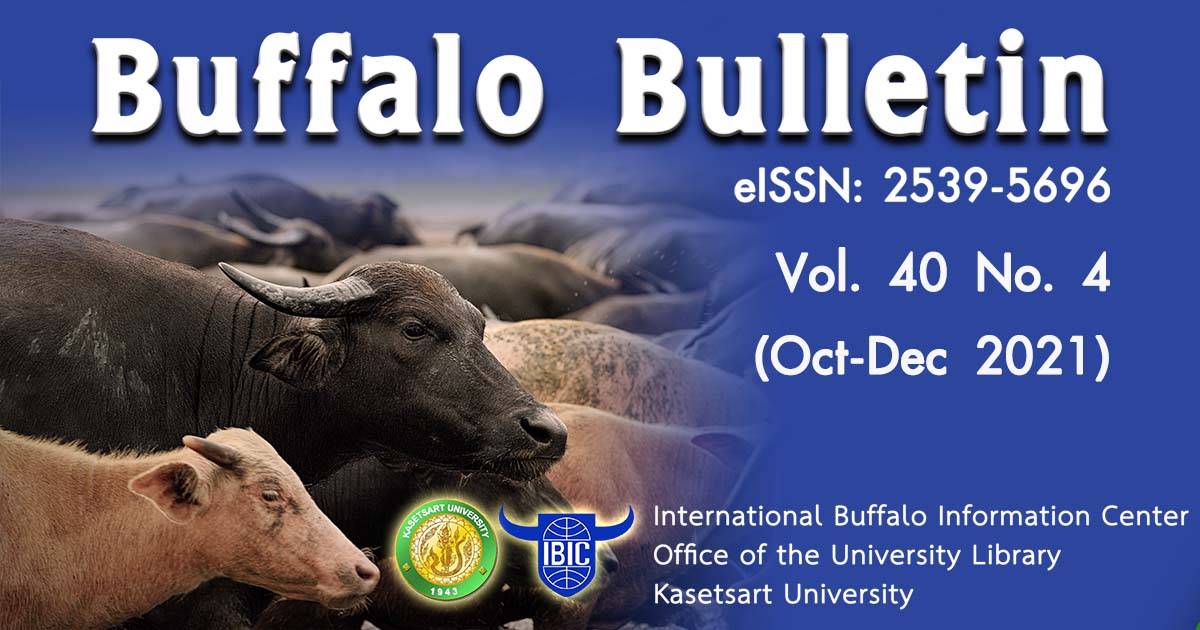An open label study to assess the efficacy of ceftiofur in treatment of clinical mastitis in buffaloes
Keywords:
Bubalus bubalis, buffaloes, lactation, clinical mastitis, antibiotic sensitivity, CeftiofurAbstract
The study objective was to evaluate the efficacy of Ceftiofur hydrochloride intramammary (IMM) formulation (Spectramast LC, Zoetis India) with or without parenteral Cefoperazone/Sulbactum antibiotic on bacteriological cure, clinical cure and pathogen cure in lactation clinical mastitis (CM) when compared with control group treated with Amoxicillin-Sulbactum. The study was conducted from September 2015 through December 2017 on lactating buffaloes suffering from clinical mastitis (n=307) (Treatment group, T1 = 156 and Control group, T2 = 151) mostly at farmer’s doorstep and also the participation of organized buffalo herds located at Hisar (n=2), Sirsa (n=1) from Haryana and at Nabha (n=1) from Punjab after follow up 1 and 2 at day 10 and 21 respectively. Infected quarters in Grade I and II lactation CM Treatment group (T1) were treated from day 0 to day 4 i.e. for 5 consecutive days with Ceftiofur hydrochloride IMM formulation or in Grade III lactation CM, IMM Ceftiofur hydrochloride along with parenteral Cefoperazone/Sulbactum. Control group (T2) received treatment from day 0 to day 2 i.e. for 3 consecutive days with Amoxicillin-Sulbactum antibiotic. Of 307 buffaloes infected with CM at day 0 pre-treatment, 93.49% of milk samples came culture positive whereas 52.12% (n=160/307) and 29.64% (91/307) of culture positive milk samples were there at day 10 and day 21 post-treatment respectively. Coagulase-negative Staphylococcus was the most prevalent causative agent followed by other gram positive, mixed infection, Escherichia coli, Staphylococcus aureus, Streptococcus spp, other coliform, Pseudomonas, other gram negative and Enterococcus spp. While apparent bacteriological cure rate of IMI was 50.37% (at animal level) at day 10 post-treatment in the Treatment group receiving Spectramast LC, it was 77.78% at day 21 post-treatment in the same group. The bacteriological cure rate of 45.45% and 57.58% were observed at day 10 and day 21 post-treatment in Control group respectively. Buffaloes receiving Spectramast LC (Treatment group) were 1.12 times (at day 10) and 1.35 times (at day 21) more likely to cure than Control group. Treatment group showed numerically higher clinical and pathogen cure than control group.
Downloads
Metrics
References
Bradley, A.J. 2002. Bovine mastitis: An evolving disease. Vet. J., 164(2): 116-128. DOI: 10.1053/tvjl.2002.0724
Bradley, A.J. and M.J. Green. 2009. Factors affecting cure when treating bovine clinical mastitis with cephalosporin-based intramammary preparations. J. Dairy Sci., 92(5): 1941-1953. DOI: 10.3168/jds.2008-1497
Chassagne, M., J. Barnouin and J.P. Chacornac. 1998. Biological predictors for early clinical mastitis occurrence in Holstein cows under field conditions in France. Prev. Vet. Med., 35(1): 29-38. DOI: 10.1016/s0167-5877(97)00092-5
Dohoo, I.R. and K.E. Leslie. 1991. Evaluation of changes insomatic cell counts as indicators of new intramammaryinfections. Prev. Vet. Med., 10(2): 225-237. DOI: 10.1016/0167-5877(91)90006-N
Dua, K. 2001. Incidence aetiology and estimated loss due to mastitis in India- An update. Indian Dairyman, 53: 41-48.
Halasa, T., K. Huijps, O. Osteras and H. Hogeveen. 2007. Economic effects of bovine mastitis and mastitis management: A review. Vet. Quart., 29(1): 18-31. DOI: 10.1080/01652176.2007.9695224
Moore, D.A., J.S. Cullor, R.H. Bondurant and W.M. Sischo. 1991. Preliminary field evidence for the association of clinical mastitis with altered interestrus intervals in dairy cattle. Theriogenology, 36(2): 257-265. DOI: 10.1016/0093-691x(91)90384-p
NMC. 1999. NMC Laboratory Handbook on Bovine Mastitis. National Mastitis Council Inc., Madison, Wisconsin, USA.
Oliver, S.P., R.A. Almeida, B.E. Gillespie, S.J. Headrick, H.H. Dowlen, D.L. Johnson, K.C. Lamar, S.T. Chester and W.M. Moseley. 2004. Extended ceftiofur therapy for treatment of experimentally-induced Streptococcus uberis mastitis in lactating dairy cattle. J. Dairy Sci., 87(10): 3322-3329. DOI: 10.3168/jds.S0022-0302(04)73468-2
Oliver, S.P. and B.A. Mitchell. 1983. Susceptibility of bovine mammary gland to infections during the dry period. J. Dairy Sci., 66(5): 1162-1166. DOI: 10.3168/jds.S0022-0302(83)81913-4
Quinn, P.J., M.E. Carter, B. Markey and G.R. Carter. 1994. Clinical Veterinary Microbiology, Wolfe, London, UK.
Radostits, O.M., C.C. Gay, Blood D.C. and K.W. Hinchcliff. 2000. Mastitis. In Veterinary Medicine, A Textbook of the Diseases of Cattle, Sheep, Pigs, Goats and Horses, 9th ed. W.B. Saunders Co., Philadelphia, USA.
Ruegg, P.L. 2003. Investigation of mastitis problems on farms. Vet. Clin. N. Am. Food A., 19(1): 47-73. DOI: 10.1016/s0749-0720(02)00078-6
Schukken, Y.H., M.J. Zurakowski, B.J. Rauch, B. Gross, L.L. Tikofsky and F.L. Welcome. 2013. Noninferiority trial comparing a first-generation cephalosporin with a third-generation cephalosporin in the treatment of nonsevere clinical mastitis in dairy cows. J. Dairy Sci., 96(10): 6763-6774. DOI: 10.3168/jds.2013-6713
Seegers, H., C. Fourichon and F. Beaudeau. 2003. Production effects related to mastitis and mastitis economics in dairy cattle herds. Vet. Res., 34(5): 475-491. DOI: 10.1051/vetres:2003027
Thomas, V., A. de Jong, H. Moyaert, S. Simjee, F.El. Garch, I. Morrissey, H. Marion and M. Valle. 2015. Antimicrobial susceptibility monitoring of mastitis pathogens isolated from acute cases of clinical mastitis in dairy cows across Europe: VetPath results. Int. J. Antimicrob. Ag., 46(1): 13-20. DOI: 10.1016/j.ijantimicag.2015.03.013
Watts, J.L. 1988. Etiological agents of bovine mastitis. Vet. Mmicrobiol., 16(1): 41-66. DOI: 10.1016/0378-1135(88)90126-5





.png)








